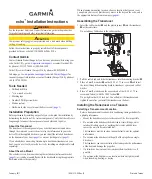
10
ABOUT TRANSDUCERS
Cone of Sound
The cone of sound is the area the sound waves cover
as they are emitted from the transducer. Generally,
this area is thought of as three-dimensional cone,
such as an upside-down ice cream cone. Actually,
the cone of sound is not so precisely defined. It is
an irregular shape with edges that taper rather than
end abruptly. Additionally, the cone of sound will
vary slightly from transducer to transducer.
Most objects are visible inside the theoretical cone,
but you can also see objects outside the theoretical
angle yet within the side and main lobes. These
objects must be large enough to sufficiently reflect
the sonar signal. Some of these objects can be
things like the face of a sharp dropping bottom, a
large rock, or even a good size fish or tight group of
smaller fish.
Transducer
Side Lobe
Not all of the sound
waves come out of the
transducer’s bottom.
Some sound comes
out the sides and even
the top.
Main Lobe
The main lobe is
where most of the
sound waves go.
They extend out in
all directions, some
sides more than
others.
Theoretical Cone Angle
The theoretical cone angle
is what the transducer’s
specification defines.
This is the area where
the intensity of the sound
waves drop to a specific
point (-6dB).
The FLX-30
bb
uses a special broad band transducer that offers a wide
spectrum of cone angles that vary with each frequency. The multi-frequency
system has different characteristics than the single-frequency transducer
described here. The Broad Band transducer does not have side lobes.
Содержание FL-18
Страница 2: ......




























